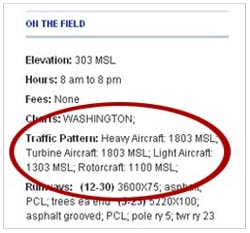
The following stories from the December 28, 2007, edition of AOPA ePilot were provided to AOPA members who expressed an interest in the particular subject areas. Any AOPA member can receive information tailored to their areas of interest by updating their preferences online.
My ePilot - Student Interest, Training Tips
KNOW THE TPA
It's the pivot point for all flying in an airport's vicinity, especially the arrivals and departures reviewed in recent Training Tips. That's why knowing and using the correct traffic pattern altitude (TPA) is vitally important. There are general rules, but many airports require a TPA other than the normal 1,000 feet agl. So no "ballparking" allowed; research the TPA and adhere to it within 100 feet-as required in the Private Pilot Practical Test Standards, Area of Operation III, Task B.
 "Traffic pattern altitudes can range between 600 and 1,500 feet agl. Some airports that have mixed traffic may have several TPAs-for example, one for light aircraft, another for heavier aircraft, and perhaps a third for helicopters. Chapter 4-3-3 of the Aeronautical Information Manual (AIM) states that 1,000 feet agl is the recommended pattern altitude unless established otherwise. It is the airport management that 'establishes otherwise.' The Airport/Facility Directory (A/FD) lists traffic pattern altitudes that are different from the 1,000-foot general recommendation. So if no TPA is listed for a particular airport, the 1,000-foot recommendation would apply. However, sometimes airport management decides to set or change a traffic pattern altitude (within the parameters of 600 to 1,500 feet) and the new TPA is not listed in the A/FD," explained this answer to the Final Exam question in the Aug. 29, 2003, AOPA ePilot newsletter. As an example, see this notice of TPA changes at the Venice, Fla., airport. You also can find an airport’s TPA in AOPA’s Airport Directory Online.
"Traffic pattern altitudes can range between 600 and 1,500 feet agl. Some airports that have mixed traffic may have several TPAs-for example, one for light aircraft, another for heavier aircraft, and perhaps a third for helicopters. Chapter 4-3-3 of the Aeronautical Information Manual (AIM) states that 1,000 feet agl is the recommended pattern altitude unless established otherwise. It is the airport management that 'establishes otherwise.' The Airport/Facility Directory (A/FD) lists traffic pattern altitudes that are different from the 1,000-foot general recommendation. So if no TPA is listed for a particular airport, the 1,000-foot recommendation would apply. However, sometimes airport management decides to set or change a traffic pattern altitude (within the parameters of 600 to 1,500 feet) and the new TPA is not listed in the A/FD," explained this answer to the Final Exam question in the Aug. 29, 2003, AOPA ePilot newsletter. As an example, see this notice of TPA changes at the Venice, Fla., airport. You also can find an airport’s TPA in AOPA’s Airport Directory Online.
Finding yourself at the wrong altitude when nearing the airport reflects poor descent planning. Alton K. Marsh offers excellent remedies in the February 2003 AOPA Pilot article "Get Down!" including these positional factors to consider: "Tuning in the airport weather information and figuring out the runway in use, as well as knowing the direction of traffic for that runway, also can affect descent planning. For example, do you want to be west of the airport when reaching pattern altitude? East? It is rare that you would want to be overhead, unless you need to see the windsock or just need to locate the field."
So don't leave your TPA to guesses or assumptions. Look up the magic number, and then use it.
My ePilot - Training Product
SKY HIGH GEAR INTRODUCES SMALLER FLIGHT BAG
Sometimes you don't need a large, bulky flight bag to tote your flying essentials-for a trip around the pattern, or for a CFI in the right seat who needs to carry the basics. If a smaller bag would be more suitable for your mission, consider the Sky High Gear Freedom VII flight bag, available from ClassicJet.com. Constructed of ballistic nylon, the bag is 13.5 by 9.5 by 5.5 inches and comes in a choice of color accents. It sells for $34. Order the bag online.
Note: Products listed have not been evaluated by ePilot editors unless otherwise noted. AOPA assumes no responsibility for products or services listed or for claims or actions by manufacturers or vendors.
My ePilot - Student Interest, Final Exam
Question: Is there an FAA regulation that says a pilot must be able to reach all required flight controls?
Answer: There isn't a direct regulation to address this; however, FAR 91.105, "Flight crewmembers at stations," states that crewmembers be at their pilot stations during the takeoff, landing, and en route stages of a flight in order to perform their necessary duties. Pilots who need pillows or cushions to elevate themselves in order to see over the panel should exercise common sense in order to safely operate the aircraft. The AOPA Flight Training article, CFI to CFI: Physically challenged students, discusses the issue of being physically challenged within the cockpit environment.
Got a question for our technical services staff? E-mail to [email protected] or call the Pilot Information Center, 800/872-2672. Don't forget the online archive of "Final Exam" questions and answers, searchable by keyword or topic.
